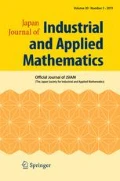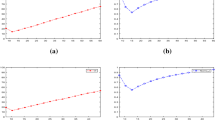Abstract
In this paper, for the implicit complementarity problem, it is shown that the solution’s sign patterns can be calculated via solving a linear system under some assumptions. Next, Newton iteration is applied to a equivalent nonlinear equation with quadratic convergence and the non-singularity of the Jacobian is discussed. Moreover, a superlinearly convergent hybrid method is established by combining an existing globally convergent iteration and the Newton iteration. Numerical examples show that the proposed methods have higher precision and converge faster than some existing methods.






Similar content being viewed by others
References
Bai, Z.-Z.: On the convergence of the multisplitting methods for the linear complementarity problem. SIAM J. Matrix Anal. Appl. 21, 67–78 (1999)
Bai, Z.-Z.: Modulus-based matrix splitting iteration methods for linear complementarity problems. Numer. Linear Algebra Appl. 17, 917–933 (2010)
Baiocchi, C., Capelo, A.: Variational Inequalities and Quasi-variational Inequalities: Applications to Free Boundary Value Problems. Wiley, New York (1984)
Berman, A., Plemmons, R.J.: Nonnegative Matrix in the Mathematical Sciences. SIAM Publisher, Philadelphia (1994)
Cao, Y., Wang, A.: Two-step modulus-based matrix splitting iteration methods for implicit complementarity problems. Numer. Algor. 82, 1377–1394 (2019)
Cui, L.-B., Li, C.-X., Wu, S.-L.: The relaxation convergence of multisplitting AOR method for linear complementarity problem. Linear Multilinear Algeb. (2018). https://doi.org/10.1080/03081087.2018.1511680
Hong, J.-T., Li, C.-L.: Modulus-based matrix splitting iteration methods for a class of implicit complementarity problems. Numer. Linear Algebra Appl. 23, 629–641 (2016)
Isac, G.: Leray–Schauder Type Alternatives, Complementarity Problems and Variational Inequalities. Springer, Boston (2006)
Ke, Y.-F., Ma, C.-F., Zhang, H.: The modulus-based matrix splitting iteration methods for second-order cone linear complementarity problems. Numer. Algor. 79, 1283 (2018)
Li, C.-L., Hong, J.-T.: Modulus-based synchronous multisplitting iteration methods for an implicit complementarity problem. East Asian J. Appl. Math. 7, 363–375 (2017)
Mezzadri, F., Galligani, E.: Modulus-based matrix splitting methods for horizontal linear complementarity problems. Numer. Algor. (2019). https://doi.org/10.1007/s11075-019-00677-y
Mosco, U.: On Some Nonlinear Quasi Variational Inequalities and Implicit Complementarity Problems in Stochastic Control Theory in Variational Inequalities and Complementarity Problems. Wiley, New York (1980)
Saberi Najafi, H., Edalatpanah, S.A.: On the convergence regions of generalized accelerated overrelaxation method for linear complementarity problems. J. Optimiz. Theory Appl. 156, 859–866 (2013)
Noor, M.: Fixed point approach for complementarity problems. J. Math. Anal. Appl. 133, 437–448 (1988)
Pang, J.-S.: On the convergence of a basic iterative method for the implicit complementarity problems. J. Optimiz. Theory Appl. 37, 149–162 (1982)
Pang, J.-S.: The Implicit Complemenarity Problem. Academic Press, San Diego (1992)
Qi, L.-Q., Sun, J.: A nonsmooth version of Newton’s method. Math. Program. 58, 353–367 (1993)
Wu, S.-L., Guo, P.: Modulus-based matrix splitting algorithms for the quasi-complementarity problems. Appl. Numer. Math. 132, 127–137 (2018)
Xia, Z.-C., Li, C.-L.: Modulus-based matrix splitting iteration methods for a class of nonlinear complementarity problem. Appl. Math. Comput. 271, 34–42 (2015)
Xu, W.-W.: Modified general modulus-based matrix splitting method for linear complementarity problems of H-matrices. Numer. Linear Algebra Appl. 22(4), 748–760 (2015)
Yuan, Q., Yin, H.-Y.: Stationary point of the minimization reformulations of implicit complementarity problems. Numer. Math. Theory Me. Appl. 31, 11–18 (2009)
Zhan, W.-P., Zhou, S.-Z., Zeng, J.-P.: Iterative methods for a kind of quasi-complementarity problems. Acta Math. Appl. Sin. 23, 551–556 (2000)
Zheng, H., Li, W., Vong, S.: A relaxation modulus-based matrix splitting iteration method for solving linear complementarity problems. Numer. Algor. 74, 137–152 (2017)
Zheng, H., Vong, S.: A modified modulus-based matrix splitting iteration method for solving implicit complementarity problems. Numer. Algor. 82, 573–592 (2019)
Zheng, H., Vong, S.: On convergence of the modulus-based matrix splitting iteration method for horizontal linear complementarity problems of \(H_+\)-matrices. Appl. Math. Comput. (2019). https://doi.org/10.1016/j.amc.2019.124890
Acknowledgements
The work was supported by the National Natural Science Foundation of China (Grant no. 11601340), Major Projects of Guangdong Education Department for Foundation Research and Applied Research (No. 2018KZDXM065) and the Young Innovative Talents Project from Guangdong Provincial Department of Education (Nos. 2018KQNCX230, 2018KQNCX233).
Author information
Authors and Affiliations
Corresponding author
Additional information
Publisher's Note
Springer Nature remains neutral with regard to jurisdictional claims in published maps and institutional affiliations.
About this article
Cite this article
Zheng, H., Qu, W. Superlinearly convergent methods for solving a class of implicit complementarity problems based on sign analysis. Japan J. Indust. Appl. Math. 37, 433–447 (2020). https://doi.org/10.1007/s13160-020-00405-3
Received:
Revised:
Published:
Issue Date:
DOI: https://doi.org/10.1007/s13160-020-00405-3
Keywords
- Implicit complementarity problem
- Sign pattern
- Modulus-based matrix splitting iteration method
- Hybrid method




